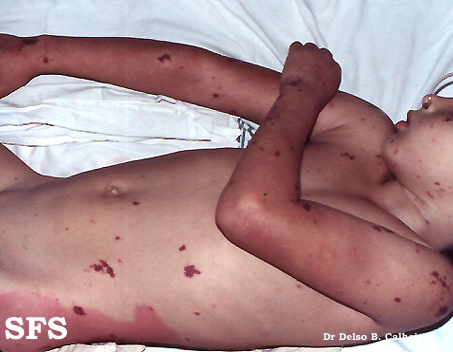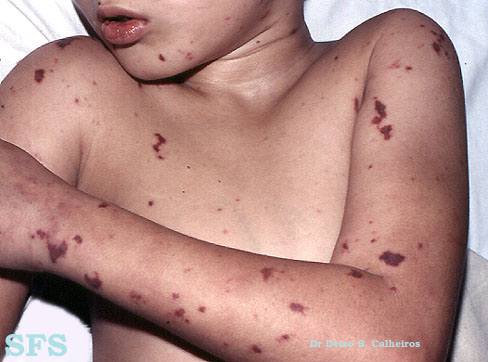Meningococcemia physical examination
Jump to navigation
Jump to search
|
Meningococcemia Microchapters |
|
Diagnosis |
|---|
|
Treatment |
|
Case Studies |
|
Meningococcemia physical examination On the Web |
|
American Roentgen Ray Society Images of Meningococcemia physical examination |
|
Risk calculators and risk factors for Meningococcemia physical examination |
Editor-In-Chief: C. Michael Gibson, M.S., M.D. [1]; Associate Editor(s)-In-Chief: Cafer Zorkun, M.D., Ph.D. [2]; Ammu Susheela, M.D. [3]
Overview
Physical examination may show fever, hypotension, petechial rash, conjuctival congestion, nuchal rigidity, seizures, edema, hepatosplenomegaly, dyspnea and rales.
Physical Examination
Appearance of the Patient
One of four scenarios is often present:
- Bacteremia without sepsis. Admission for upper respiratory illness or viral exanthem. Positive blood cultures for Neisseria meningitidis.
- Meningococcemia without meningitis. Septic patient with leukocytosis, skin rashes, generalized malaise, weakness, headache, and hypotension on admission or shortly after.
- Meningitis with or without meningococcemia. Patients with headache, fever, meningeal signs and cloudy spinal fluid. No pathologic reflexes.
- Meningoencephalitic presentation. Profoundly obtunded with meningeal signs and septic spinal fluid. Altered reflexes (either absent or rarely hyperactive). Pathologic reflexes are often present.[1]
Vital Signs
- Fever
- Not infrequently hypotension and shock
Skin
- Petechial rash manifesting as discrete lesions 1-2 mm in diameter frequently on the trunk and lower portions of the body.
- Petechial regions can coalesce and form larger lesions that appear ecchymotic.
- A rash may appear that mimics a viral exanthem, particularly rubella. Not purpuric and non-pruritis and is transient, generally not lasting more than 2 days and is frequently gone hours after first observation.
Eyes
- Palpebral and ocular conjunctival petechia.
Heart
- Congestive heart failure, myocarditis, pericarditis may be present
Lungs
Neurologic
Nuchal rigidity and seizures may be present.
Gallery
 |
 |
 Image obtained from CDC Public Health Image Library (ID#1335) |